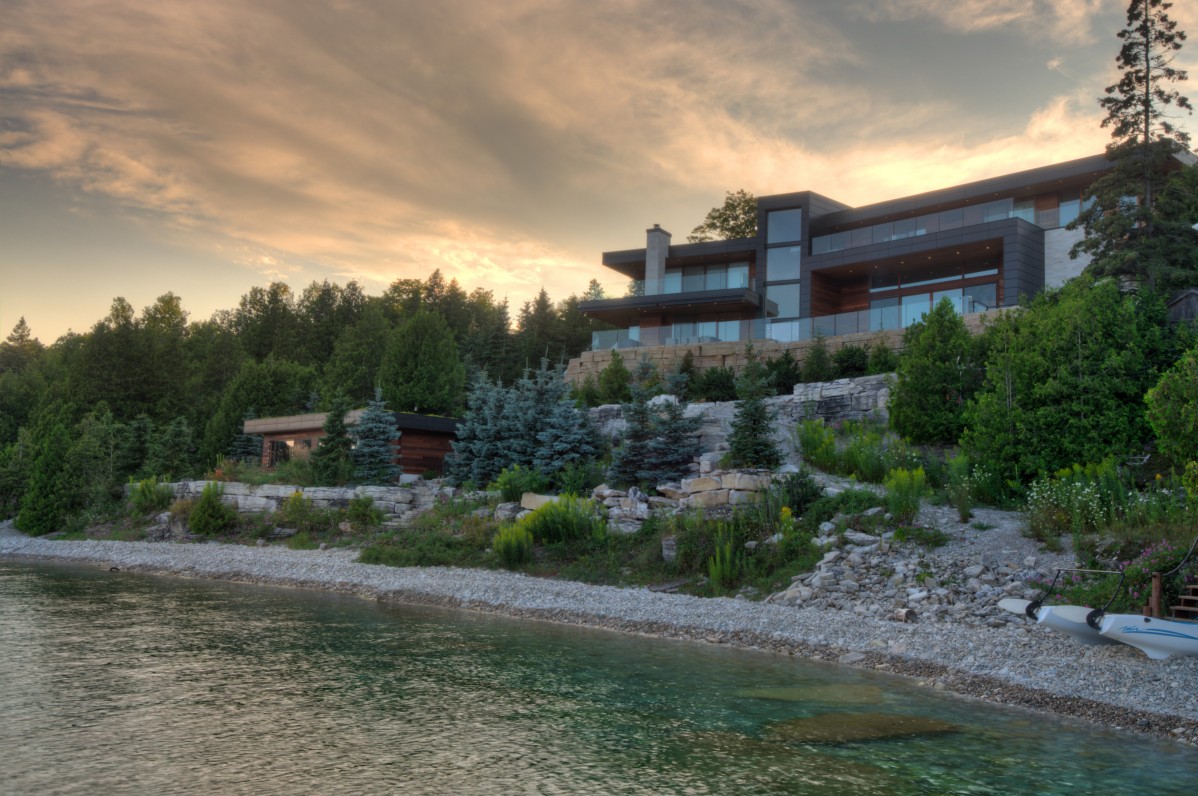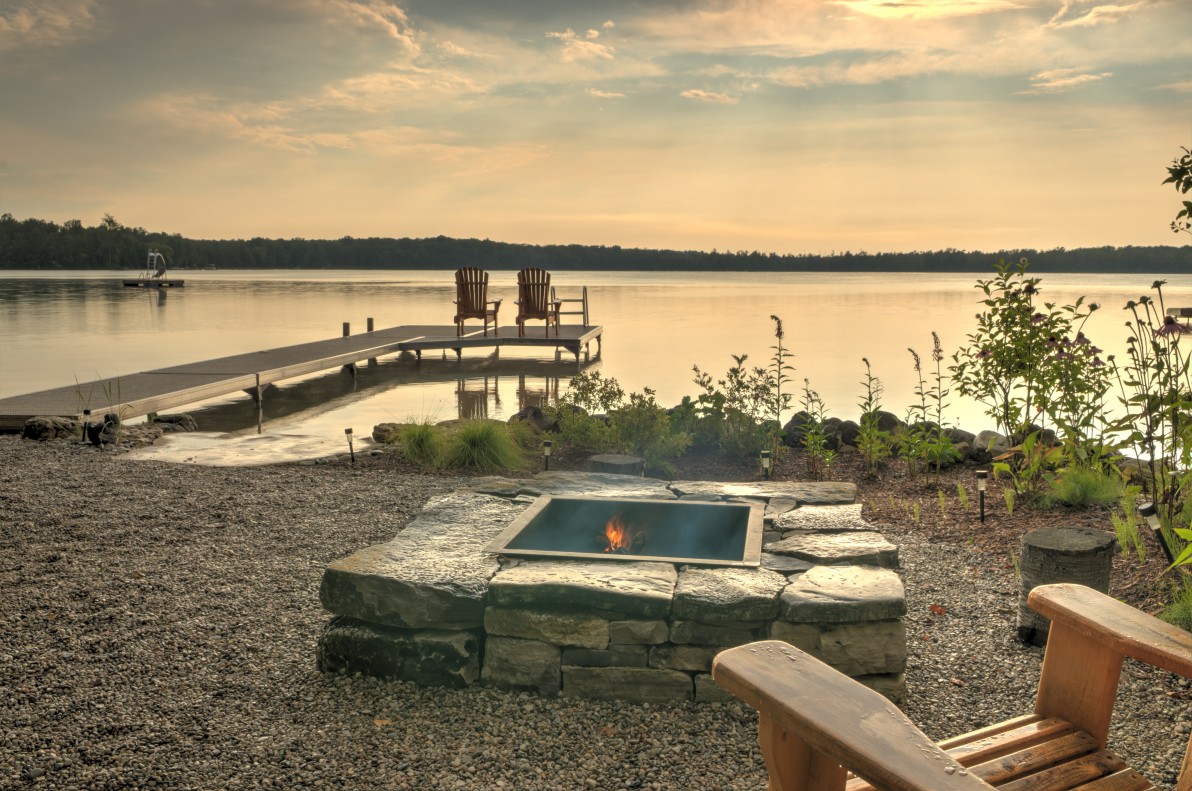For those of us fortunate enough to live on a waterfront property, the quiet spot to sit on the dock, dip our toes in the water or dive in for a swim can be a little bit of paradise.
While shorelines are amazing places for us to enjoy, they also serve a much broader purpose for nature as a whole — providing habitats for all sorts of animal and plant life. But these shoreline ecosystems are fragile and can easily be put off-balance, diminishing the overall health of lakes.
Landscaping projects are especially notorious for upsetting the intricate balance of vegetation and organisms in the shoreline ecosystem — but not if they’re done thoughtfully and carefully!
Whether it’s a cottage, a second home or just home sweet home, in this post you’ll find out why shorelines are so important, how they can be damaged and some of the ways our crews restore them again.

What makes a shoreline so special?
Before we talk about landscaping, let’s talk about why shorelines are so special in the first place!
Here’s a quick crash course in shoreline science. Every natural shoreline has four zones and each of these zones plays a critical role in preventing erosion, stopping contaminants and generally keeping your lake healthy:
- Where your dock is (the littoral zone) — The area from the water’s edge to roughly where sunlight no longer penetrates to the bottom of the water. If you have a dock, it extends into the littoral zone.
- Where the land and the water meet (the shoreline) — In its natural state, the shoreline is mostly stones, plants, shrubs, fallen limbs, and tree trunks — all of which are some of the most effective erosion control on the planet!
- The land closest to the shoreline (the riparian zone) — Here, a thick layer of plants controls erosion and sifts impurities out of surface run-off. On top of acting as a filter for the lake, the riparian zone is also a refuge for wildlife.
- The higher, dryer ground (the upland zone) — This area is typically forested with the kinds of trees that take advantage of better drainage. The trees stabilize the slopes, cool the area with shade and protect the shoreline from winds.
While each zone is important, there’s a gradual, almost seamless transition between each area. If any one of these zones is slightly altered, it can affect all of the zones and diminish how your shoreline supports life in your lake.
If you’d like to learn more about these zones and how you can keep your shoreline healthy, we encourage you to take a look at Fisheries and Oceans Canada’s The Shore Primer publication.
What are some of the common ways that shores can be damaged?
A lot of the time, shorelines are damaged by well-intentioned people looking to improve their waterfront living.
Below are some of the most common ways that we see shores damaged in the Grey and Bruce Counties:
- Clearing out trees, plants and shrubs that line the shoreline for a better view of the water from inside their home, or on their deck or patio. Removing any native shore vegetation allows contaminants to flow directly into the lake!
- Dumping truckloads of sand along the shoreline to create a beach area, completely destroying the littoral zone.
- Building concrete break-walls to prevent shoreline erosion — this usually happens after a shore has already been tampered with. Hardening a shore with concrete “sterilizes” it, preventing any plants or animals from sticking around. They also break down over time and need to be repaired or replaced.
- Adding a poorly-designed dock that damages and fragments your lake’s fragile habitat. Certain docks styles are much better suited for lakefront living. Our advice? Use your dock as a “bridge” over your shoreline rather than tampering with the shore.
In our region, water levels in the Great Lakes are rising every year! These increased levels are creating much higher waves than we’re used to seeing. These big and powerful waves are another one of the leading causes of shoreline erosion.
In all of these activities, the interesting thing to note is that there’s a “tug-of-war” that tends to happen between property owners and the shoreline, with neither side winning in the end. Our suggestion is to reframe your perspective! There are strategies to prevent damage and even cooperate with nature… while still enjoying the great outdoors. We call it shoreline restoration!

What is shoreline restoration?
The goal of shoreline restoration is to protect and nurture the qualities that make your shoreline such a special location. Our goal is to offer cottagers and other landowners constructive solutions for restoring an altered shoreline to its former health and beauty.
Some of our most basic strategies for shoreline restoration:
- Lessening your lawn’s impact. — Lawns and lakes don’t always get along, as lawns can displace the native plants that protect the lake from pollution and erosion. But that isn’t to say they can’t get along! Rather than getting rid of your lawn completely, use natural methods to maintain it and avoid chemical fertilizer or herbicides. Another solution is to build a buffer of native plants between the shoreline and your turf. An angled pathway can lead through this buffer to your dock.
- Switching to a shoreline-friendly dock. — Choose your site and your materials carefully. Floating docks are the least damaging, though pipe and pile docks can also be good options. The idea is to install something that isn’t permanent, has a small footprint and can be changed along with water levels. It’s also good to install on a site with minimal impact on the ecosystem — look for a spot with little or no vegetation, and try to develop only 25% of your total frontage. At Hutten, we specialize in marine-grade aluminum docks — ask us to find out more!
- Softening your shoreline if it’s too “hard.” — When concrete break-walls are installed, shorelines become “hard” and very quickly look almost lifeless! Ideally, break-walls are removed if they’re crumbling or in need of repair. But if that’s not an option, install a buffer of native shrubs, and pile stones at a 45-degree angle in front of the wall. Both of these will prevent erosion and encourage the growth of aquatic plants. But be careful, as you may need the approval of government authorities.
Remember, these are very basic overviews — there’s a lot more involved than what you’re reading here. If you’d like some help restoring your shoreline, please reach out to our shoreline experts! We’re happy to help with your next project.
In the meantime, feel free to read our next post, where you can figure out what type of shoreline is on your property and how you can care for it.




